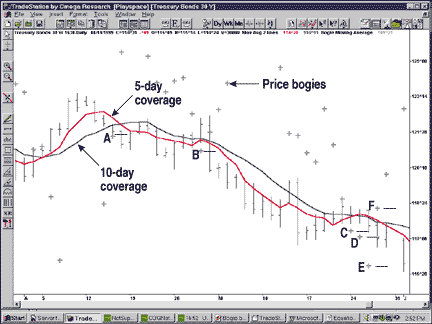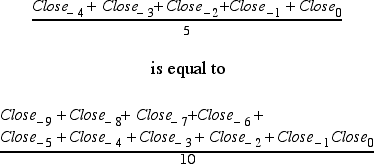BASIC TECHNIQUES
Triggering Your Trading Signal
by Benjamin L. Cotton
Here's an indicator that calculates the future price movement necessary to trigger a moving average condition, removing the guesswork from systems trading based on such relationships.
Every trader has indicators to track the market with, but if the indicators are dependent upon a price that has yet to occur, the patience and time needed to track the entire body of stocks of concern to us can be tedious. There's a way to get directly to what you want to know, which is what price will trip the indicators to generate a signal.

FIGURE 1: 30-YEAR TREASURY BONDS, TARGET PRICE. Crosses mark the price at which the crossover in the five- to 10-day moving averages would occur on the next bar. At point A, the target is just below the bar, and on the next day, the bar closes below the target, forcing a crossover. At B, any close above the target would force a crossover, but the close ends up lower. At C, any close above the target forces a crossover and that's what happens. At D, if the close had been below the target price, a recrossover would have occurred. The same goes for E. At F, it would have taken a close above the target to prevent a crossover.
Here's how to get what you need with some basic algebra. Say you want to know the price at which a five-day moving average is equal to a 10-day moving average. Why? Because all crossovers and crossunders pass through equality at one point or another. Assuming we are using the close, this condition is:

is equal to
Close0 = Today's close
Close-1 = Closing price yesterday
The only unknown in this relationship is Close0, so we isolate the unknown and restate the equality as follows:

Or, more generically:

This just indicates that on each side of the equality, the summation of the known-quantity closes is added to the unknown close and then divided by the total number of closes. All you have to do is solve for the unknown close variable, which is today's close. That turns out to be:
![]()
Benjamin L. Cotton is a research/portfolio manager for SAI Capital Management, an investment management firm located in Seal Beach, CA, specializing in tactical asset allocation. He is a member of the Association for Investment Management and Research, the Los Angeles Society of Financial Analysts, and a Chartered Financial Analyst candidate. He may be reached via E-mail at blcotton@pacbell.net.
Excerpted from an article originally published in the November 1999 issue of Technical Analysis of STOCKS & COMMODITIES magazine. All rights reserved. © Copyright 1999, Technical Analysis, Inc.
Return to November 1999 Contents